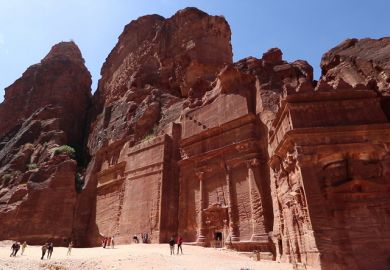C ourtly Art of the Ancient Maya is the eponymous companion volume to the exhibition that visited the National Gallery of Art in Washington and then moved on to the Fine Arts Museum of San Francisco before ending its run in January. The exhibition brought together an unprecedented grouping of Maya masterworks from royal courts of the Classic Period (c. AD250-900), ranging from massive stone sculptures to small, meticulously detailed ceramic figurines and shell and jade objects that would fit in the palm of a hand.
The show was also a testament to the hard work and diplomacy of its organisers, who were able to reach agreements to exhibit pieces from national and regional museums in Mexico, Guatemala and Honduras alongside artefacts from other museums and private holdings worldwide.
Taken simply as a catalogue of that exhibition, this is a beautiful book. I saw "Courtly Art" during its run in Washington and was overwhelmed by the sheer abundance of artwork. My mind could not absorb the details of every piece in the little time I had to move through the galleries; I wanted to linger over a jade pendant, to stare for hours pulling out all the details in a painted court scene on a vase. With this book, it is possible to revisit a vase one day, a carved lintel the next, to spend five minutes or twenty.
The text and imagery of the book are organised with a plot in mind, and it can be read straight through, as the reader is shown the different aspects of the royal court beginning with daily life, moving on to religious beliefs, courtly women, the significance of hieroglyphic writing and scribes, before closing with warfare. All these are then brought together and illustrated with a discussion of a particular royal court at the centre of Palenque, Mexico.
The 328 illustrations, 233 of them in colour, are beautifully reproduced, and many cover a full page. When the details of a sculpture or painting demand more attention, the book provides close-up photographs. Line drawings of many objects provide representations that - in their simplified, high-contrast and often more intelligible imagery - provide new information for the reader.
Yet Mary Miller and Simon Martin have put together much more than a mere exhibition catalogue. It might be more appropriate to think of Courtly Art as a Rosetta Stone; a beautifully illustrated guide that deciphers the often-cryptic art and iconography of the ancient Maya for the casual viewer and the expert alike. Classic Period Maya civilisation is profoundly foreign to residents of the 21st century, and the artwork at its most elaborate can seem inaccessible. Miller and Martin guide us through each piece, pulling apart the component figures and hieroglyphic texts to render each intelligible. They then rebuild the significance of imagery and the written word as it pertains to the individual object and, more importantly, to the wider culture and society that produced such finery.
In this - the decryption of Maya imagery and text and the reconstruction of the cultural whole within which each piece fits - Courtly Art offers a significant contribution to Maya studies. To say that the book is academically significant, however, is not to say that it is a dry description of Maya art, history and archaeology. Through the first six chapters, Miller and Martin's fast-paced and engaging prose draws the reader into the mindset (as best we understand it) of the rulers of a civilisation that saw its heyday when Europe was in the Dark Ages.
The final chapter, "New discoveries and personal accounts in the Maya west", offers a series of vignettes from Mexican, Guatemalan, Italian and American scholars detailing the latest discoveries from the royal courts of Palenque, Bonampak, Yaxchil n and Piedras Negras. These offerings move beyond art history and epigraphy and encompass everything from recent discoveries by archaeologists and considerations of the built environment, to chemical assessments of the composition of Maya mural paintings and more.
Some might quibble that the content of Courtly Art focuses largely on a relatively few sites in a restricted geographic range - primarily the Usumacinta River drainage of the western Petén in Guatemala and eastern Chiapas and Tabasco in Mexico, with the art and history of Palenque being the centrepiece of the book. But it was at Palenque and its neighbours that the Maya artists were most exuberant, experimental and prolific in the depiction of the royal court, allowing us the greatest insight into the lives of nobles, courtiers, kings, queens and captives. Moreover, although these western Maya sites as a group dominate the book, they are nicely balanced by pieces from more widely scattered sites ranging from the Yucatán Peninsula to Honduras.
Miller and Martin have found a fine balance. They have created a beautifully illustrated exhibition catalogue that provides keen insight into the culture of the Classic Maya royal court. Courtly Art of the Ancient Maya is a superb publication that is equally at home in the classroom or on the coffee table.
Charles Golden is assistant professor in anthropology, Brandeis University, Massachusetts, US.
Courtly Art of the Ancient Maya
Author - Mary Miller and Simon Martin
Publisher - Thames and Hudson
Pages - 304
Price - £35.00
ISBN - 0 500 05129 1
Register to continue
Why register?
- Registration is free and only takes a moment
- Once registered, you can read 3 articles a month
- Sign up for our newsletter
Subscribe
Or subscribe for unlimited access to:
- Unlimited access to news, views, insights & reviews
- Digital editions
- Digital access to THE’s university and college rankings analysis
Already registered or a current subscriber? Login



